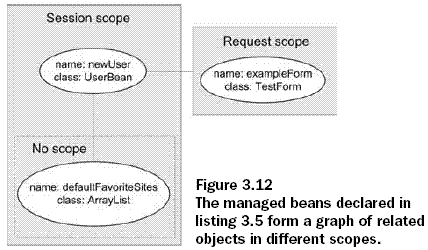2008.04.15 摘自 JSF in action 3.3.3 Setting values with value-binding expressions Page/159
1. JSF 中可以通过使用JSF 的EL(Expression Language)语言来引用之前创建的Managed Bean来初始化当前Managed Bean的属性,EL表达式放在#{...}中,具体的语法同组件上的EL表达式一样,可以参考之前的<jsf in action 笔记:页面语言(Expression Language)--2008.04.09 >,这种值绑定(value-binding)的方式与Spring中的依赖注入(Dependence Injection)模式有相同之处.以下为.xml配置文件中的示例代码:以下为示例图:
 <
managed-bean
>
<
managed-bean
>
 <
managed-bean-name
>
defaultFavoriteSites
</
managed-bean-name
>
<
managed-bean-name
>
defaultFavoriteSites
</
managed-bean-name
>
 <
managed-bean-class
>
java.util.ArrayList
</
managed-bean-class
>
<
managed-bean-class
>
java.util.ArrayList
</
managed-bean-class
>
 <
managed-bean-scope
>
none
</
managed-bean-scope
>
注: 没有放入到任何的scope中
<
managed-bean-scope
>
none
</
managed-bean-scope
>
注: 没有放入到任何的scope中 <
list-entries
>
<
list-entries
>
 <
value
>
http://www.jsfcentral.com
</
value
>
<
value
>
http://www.jsfcentral.com
</
value
>
 <
value
>
http://www.theserverside.com
</
value
>
<
value
>
http://www.theserverside.com
</
value
>
 <
value
>
http://www.ibm.com/developerworks/
</
value
>
<
value
>
http://www.ibm.com/developerworks/
</
value
>
 <
value
>
http://otn.oracle.com
</
value
>
<
value
>
http://otn.oracle.com
</
value
>
 <
value
>
http://www.java.net
</
value
>
<
value
>
http://www.java.net
</
value
>
 <
value
>
http://www.manning.com
</
value
>
<
value
>
http://www.manning.com
</
value
>
 </
list-entries
>
</
list-entries
>
 </
managed-bean
>
</
managed-bean
>
 <
managed-bean
>
<
managed-bean
>
 <
description
>
Default user object.
</
description
>
<
description
>
Default user object.
</
description
>
 <
managed-bean-name
>
newUser
</
managed-bean-name
>
<
managed-bean-name
>
newUser
</
managed-bean-name
>
 <
managed-bean-class
>
org.jia.examples.UserBean
</
managed-bean-class
>
<
managed-bean-class
>
org.jia.examples.UserBean
</
managed-bean-class
>
 <
managed-bean-scope
>
session
</
managed-bean-scope
>
注:存放在session的scope中
<
managed-bean-scope
>
session
</
managed-bean-scope
>
注:存放在session的scope中 <
managed-property
>
<
managed-property
>
 <
property-name
>
favoriteSites
</
property-name
>
<
property-name
>
favoriteSites
</
property-name
>
 <
value
>
#{defaultFavoriteSites}
</
value
>
注:引用value binding的方式引用的defaultFavoriteSites这个上面创建的Managed Bean
<
value
>
#{defaultFavoriteSites}
</
value
>
注:引用value binding的方式引用的defaultFavoriteSites这个上面创建的Managed Bean </
managed-property
>
</
managed-property
>
 <
managed-property
>
<
managed-property
>
 <
property-name
>
favoriteAnimal
</
property-name
>
<
property-name
>
favoriteAnimal
</
property-name
>
 <
value
>
donkey
</
value
>
<
value
>
donkey
</
value
>
 </
managed-property
>
</
managed-property
>
 </
managed-bean
>
</
managed-bean
>
 <
managed-bean
>
<
managed-bean
>
 <
managed-bean-name
>
exampleForm
</
managed-bean-name
>
<
managed-bean-name
>
exampleForm
</
managed-bean-name
>
 <
managed-bean-class
>
org.jia.examples.TestForm
</
managed-bean-class
>
<
managed-bean-class
>
org.jia.examples.TestForm
</
managed-bean-class
>
 <
managed-bean-scope
>
request
</
managed-bean-scope
>
注:存放在request的scope中
<
managed-bean-scope
>
request
</
managed-bean-scope
>
注:存放在request的scope中 <
managed-property
>
<
managed-property
>
 <
property-name
>
user
</
property-name
>
<
property-name
>
user
</
property-name
>
 <
value
>
#{newUser}
</
value
>
注:采用value binding 引用newUser Managed Bean
<
value
>
#{newUser}
</
value
>
注:采用value binding 引用newUser Managed Bean </
managed-property
>
</
managed-property
>
 </
managed-bean
>
</
managed-bean
>
exampleForm对象中的user属性指向的是存放在session中的用户newUser,newUser的favoriteSites属性是之前创建的defaultFavoriteSites这个对象,defaultFavoriteSites这个对象不存在于任何一个scope(application,session,request)中,它的值被设定为none,(原文: Because defaultFavoriteSites is declared in the scope none, it isn’t stored anywhere—it’s created solely for the purposes of setting newUser’s favoriteSites property.)它只为这个newUser单独创建,?:就是不知道是不是为每个用户都创建一次.下面为以上代码的示例图:
2. 采用JSF EL初始化Bean的属性有几条规则:
- bean中的属性指的对象的生存跨度(scope值)不应该比bean本身的生存跨度(scope值)短,应该符合下列表中的规定:
,就像上面的示例代码中exampleForm references newUser,This is okay, because newUser is stored in the session and exampleForm is stored in the request. newUser的生存跨度要比exampleForm的长,因为当一次请求及响应结束后,exampleForm就会被清除了,但是newUser还在,而且活的很开心(When the request is completed and exampleForm is removed, newUser will continue to live happily.),用户还会继续其它的一些操作.但如果newUser中存放了exampleForm这个对象,当newUser想去对exampleForm进行操作的时候,exampleForm可能已经被清除了,所以这样是不允许的.An object stored in this scope…
Can reference an object stored in this scope…
none
none
application
none, application
session
none, application, session
request
none, application, session, request
- JSF 也不支持环状,即A中引用B,B中引用A.
- JSF的值绑定配置给我们配置对象的初始值提供了很大的便利,可以在不修改代码的条件下修改其初始值.
























 被折叠的 条评论
为什么被折叠?
被折叠的 条评论
为什么被折叠?








